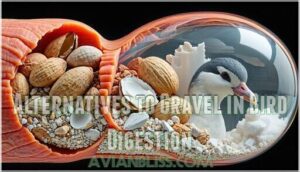This site is supported by our readers. We may earn a commission, at no cost to you, if you purchase through links.

Birds don’t actually digest gravel – they’re collecting nature’s grinding tools for their gizzards.
These muscular stomach chambers work like powerful food processors, using swallowed stones to crush tough seeds, nuts, and hard plant materials that their beaks can’t break down alone.
It’s basically like having a built-in rock tumbler that pulverizes food into digestible pieces.
This clever system lets grain-eating birds extract maximum nutrition from their meals, turning what seems like odd behavior into brilliant evolutionary engineering that’s kept species thriving for millions of years, which is a result of millions of years of adaptation and evolutionary processes that have led to this unique behavior.
Table Of Contents
- Key Takeaways
- Why Do Birds Eat Gravel?
- What is Grit and Why Do Birds Eat It?
- The Role of Gizzards in Bird Digestion
- Types of Birds That Consume Gravel
- Benefits of Gravel Consumption for Birds
- How Birds Select and Swallow Gravel
- Gastroliths: Nature’s Digestive Aids
- Gravel Consumption Across Different Bird Species
- Potential Risks of Gravel Consumption
- Alternatives to Gravel in Bird Digestion
- The Evolutionary Advantage of Gravel Eating
- Frequently Asked Questions (FAQs)
- Conclusion
Key Takeaways
- **You’ll find birds don’t actually digest gravel—they’re collecting grinding tools for their gizzards.
**These muscular stomach chambers work like food processors, using swallowed stones to crush tough seeds and plant materials their beaks can’t break down.
- **Birds lack teeth, so they’ve evolved this clever digestive system over millions of years.
**The gizzard acts as nature’s rock tumbler, with stones called gastroliths pulverizing food into digestible pieces through powerful muscular contractions.
- **Different bird species need different types and sizes of gravel based on their diets.
**Seed-eating birds like pigeons and finches actively seek small stones, while larger birds like turkeys need bigger pebbles—some turkeys consume up to half a pound of grit weekly.
- **This behavior gives birds a major evolutionary advantage by letting them access tough food sources.
**Without the weight of teeth, they can fly efficiently while still extracting maximum nutrition from hard seeds, nuts, and fibrous plants that other animals can’t process.
Why Do Birds Eat Gravel?
You’ve probably wondered why birds pick up small stones and gravel—it’s actually a brilliant digestive strategy.
Unlike you, birds lack teeth, so they rely on grit composition from various gravel sourcing locations to help their gizzards grind tough seeds and insects.
This grit for birds works like nature’s food processor, with gizzard function depending on these swallowed stones for proper bird digestion and gravel consumption patterns.
What is Grit and Why Do Birds Eat It?
In the wild, you’ll notice birds deliberately picking up small stones, sand, and tiny pebbles – but this isn’t random behavior.
This material, called grit, serves as nature’s replacement for teeth that birds simply don’t have.
Nature solved birds’ dental dilemma with an ingenious substitute: tiny stones that grind food like living millstones.
Grit composition varies widely, from quartz particles to limestone fragments.
Birds show remarkable grit selection skills, choosing pieces based on their dietary needs.
Seed-eating finches prefer fine sand grains, while turkeys grab larger pebbles for their tough plant diet.
Grit sources include riverbanks, roadsides, and shorelines where natural weathering creates perfect sizes.
The grit necessity becomes clear when you consider that without these miniature gastroliths, birds can’t properly process food.
This digestive aid transforms their gizzards into powerful grinding mills.
The dietary impact is huge – grit for birds means the difference between extracting nutrients efficiently or struggling with indigestion.
Think of it as outsourcing the chewing process to their stomachs, where these stones become essential partners in bird digestion and gizzard function.
These stones, known as essential gastroliths, aid in breaking down tough food.
The Role of Gizzards in Bird Digestion
You’ll discover that a bird’s gizzard acts like a powerful grinding mill, using swallowed stones to crush food into digestible pieces.
This muscular stomach replaces the teeth that birds don’t have, making it essential for breaking down everything from tough seeds to fibrous plant material.
How Gizzards Work
Understanding gizzard function reveals nature’s mechanical marvel.
This muscular organ works like a powerful gastric mill, using gizzard contractions to crush food against swallowed stones.
The tough koilin layer lines the interior, protecting against damage during intense grinding.
Mechanical digestion occurs as muscles rhythmically squeeze, creating tremendous pressure.
Food retention varies based on meal toughness – harder items stay longer for thorough processing.
This digestive aid transforms whole seeds into digestible particles, making bird digestion remarkably efficient without teeth.
Gizzard Anatomy
Through their muscular walls and specialized anatomy, gizzards function as nature’s gastric mill.
Nature equipped birds with the ultimate food processor – no assembly required, stones included.
You’ll find this muscular organ lined with the tough koilin layer, creating ridged surfaces that work like sandpaper.
The gizzard muscles contract powerfully, using gastroliths to grind food into digestible particles.
Food retention time varies dramatically – tough seeds might stay hours while soft items pass quickly.
Species variation is remarkable: seed-eating birds have thick, powerful gizzards, while nectar-feeders sport thin-walled versions.
This digestive system adaptation allows birds to process everything from hard nuts to fibrous plants, making the gizzard essential for bird digestion across countless species.
Types of Birds That Consume Gravel
You’ll discover that wild birds across numerous species regularly consume gravel to meet their unique dietary needs.
Granivorous birds like pigeons, turkeys, and quails depend heavily on grit size ranging from 1-20mm to process hard seeds.
Consumption frequency varies dramatically—turkeys ingest half a pound weekly, while House Sparrows show 100% grit occurrence in studies.
Habitat influence and evolutionary adaptations determine which bird species require gravel, with waterfowl selecting larger stones than finches for their specialized bird diet requirements.
Birds require this grit for digestion because they lack teeth.
Benefits of Gravel Consumption for Birds
You’ll discover that gravel consumption offers birds three major digestive advantages that make this behavior essential for survival.
These benefits transform how birds process food, from breaking down tough seeds to maximizing nutrient extraction from their meals.
Improved Digestive Efficiency
Gravel transforms your feathered friend’s digestive system into a high-efficiency food processor.
When gizzard muscles contract around these tiny stones, they create powerful grinding action that breaks food into smaller particles.
This mechanical breakdown boosts enzyme activity and nutrient uptake while reducing waste:
- Enhanced enzyme contact – More surface area means digestive enzymes work faster
- Improved gut motility – Ground food moves smoothly through the digestive system
- Optimal digestion timing – Faster processing prevents food spoilage
This digestive aid guarantees birds extract maximum nutrition from every meal.
Nutrient Absorption Enhancement
Beyond just breaking down food, gravel creates a mineral release system that supercharges bird nutrition.
When stones grind against seeds and grains, they increase surface area dramatically, exposing more nutrients to chemical digestion.
This enhanced enzyme exposure boosts absorption rate substantially.
Think of it as nature’s food processor – the grit doesn’t just crush, it releases hidden nutritional treasures that would otherwise pass through undigested.
These stones, also known as gastroliths aid digestion.
Gizzard Grinding Function
You’ll find the gizzard works like nature’s food processor, using muscular walls and gastroliths for efficient grinding.
Here’s how this digestion powerhouse operates:
- Muscular Contractions create powerful grinding motions against swallowed stones
- Koilin Protection lines the gizzard’s interior, preventing damage during processing
- Gastrolith Wear smooths stones over time, requiring periodic replacement for maximum Grinding Efficiency
Diet Influence determines gizzard strength—seed-eaters need tougher grinding chambers than nectar-feeders.
How Birds Select and Swallow Gravel
You’ll find that birds don’t randomly grab any stone they see—they’re surprisingly picky about their gravel selection, choosing pieces based on size, hardness, and availability that match their specific digestive needs.
Once they’ve spotted the perfect pebbles, birds use their beaks like precision tools to pick up stones and swallow them whole, sending these natural grinding aids straight to their muscular gizzards.
Gravel Size Preferences
When you observe birds selecting gravel, you’ll notice they’re surprisingly picky about size.
Most species target pebbles with optimal size ranging from 1-20mm average diameter, depending on their body size. Ring-necked pheasants prefer 2.3mm stones, while larger waterfowl choose 10-20mm pieces.
This grit selection reflects dietary needs – seed-eaters need smaller small stones for grinding tough shells, while species variation shows carnivorous birds selecting larger pieces for processing bones and tough prey parts.
This behavior is essential because it directly impacts gizzard efficiency.
Beak Adaptations
You’ll notice that beak morphology directly influences how birds select and consume gravel for their digestive aid.
Species variation in beak evolution reflects different feeding strategies, with diet influence shaping these essential avian adaptations over time.
Key beak features for gravel selection:
- Strong, short beaks – Perfect for handling hard seeds and selecting appropriately-sized grit particles
- Ground-foraging specializations – Help birds distinguish between food items and similar-sized gravel pieces
- Size-proportional design – Larger birds possess beaks capable of handling bigger stones for their digestive system
Different species exhibit various beak adaptations based on their diet.
Gizzard Functionality
Your bird’s muscular gizzard acts like nature’s food processor, using muscular contractions to crush seeds and grit together.
This powerful gastric mill features a tough koilin layer that resists stomach acid, while gastroliths serve as grinding stones.
To promote healthy gizzard function, consider a bird grit option.
Food retention time varies by diet, but this remarkable organ transforms your bird’s digestive system into an efficient grinding machine that compensates for lacking teeth.
Gastroliths: Nature’s Digestive Aids
You’ve probably wondered what those tiny stones in bird gizzards are actually called – they’re gastroliths, or "stomach stones," and they’re basically nature’s version of dental work.
These swallowed rocks act like grinding teeth inside the gizzard, crushing seeds, nuts, and fibrous plant material that would otherwise be impossible for toothless birds to digest, which is their primary function as a digestive aid, making them a crucial part of the bird’s gizzard.
Definition of Gastroliths
Swallowing gravel might seem odd, but these special stones called gastroliths serve as nature’s internal grinding tools.
Also known as stomach stones, these intentionally ingested rocks become your feathered friend’s personal food processors.
Here’s what makes gastroliths remarkable:
- Selective intake – Birds choose specific stone sizes and hardness levels
- Grit composition – Feldspar-rich stones provide essential minerals like potassium
- Gastrolith origins – Evidence dates back over 100 million years in fossils
- Animal gastroliths – Found in various species beyond birds, including dinosaurs
Through constant grinding action, these stones gradually smooth out, requiring gastrolith replacement when they lose effectiveness.
You can find a bird supplement here to aid in this process.
Function in Bird Digestion
Grinding food without teeth might seem impossible, but gastroliths make it work like clockwork.
These stomach stones transform your bird’s gizzard into a powerful food processor, with the tough koilin layer protecting against damage.
As gizzard motility churns stones against seeds, digestion efficiency skyrockets. Gastric juices soften materials while stones pulverize them, boosting nutrient uptake dramatically.
Think of it as nature’s blender—grit and muscular contractions create the perfect grinding action that makes bird digestion remarkably effective, even surpassing some toothed animals.
Notably, this process is aided by the unique characteristics of bird lungs, which provide the high oxygen levels needed for such intense muscular activity.
Gravel Consumption Across Different Bird Species
From understanding gastroliths, we can see how different bird species approach gravel consumption with remarkable variety. Species variation in gravel consumption reflects each bird’s unique dietary needs and habitat influence.
Dietary grit preferences split along predictable lines. Granivorous bird species like finches, sparrows, and pigeons actively seek stones since they swallow seeds whole with tough husks. Ring-necked pheasants hold the record with up to 88 gastroliths in their gizzards.
Meanwhile, insectivores rarely need grit because their soft-bodied prey doesn’t require mechanical breakdown. Waterfowl demonstrate impressive consumption frequency, constantly replacing worn stones.
Ducks and geese select larger pebbles (10-20mm) to process aquatic vegetation, while smaller shorebirds prefer particles under 5mm for grinding insects and crustaceans. Grit size correlates directly with body mass – larger birds choose bigger stones.
However, some species buck this trend. American crows use surprisingly varied sizes, while grackles select smaller particles than expected. Carnivorous birds like owls use gastroliths specifically for bird digestion of bones and fur, though hawks and falcons rarely consume gravel at all.
These dietary choices impact their specific protein needs.
Potential Risks of Gravel Consumption
While gravel consumption keeps most birds healthy, you’ll find some serious risks lurking beneath the surface. Think of it like eating too much candy—what’s normally helpful can become harmful when overdone.
Digestive issues arise when birds make poor choices or face environmental challenges that disrupt their natural instincts. Watch for these warning signs:
- Gizzard Impaction from oversized stones blocking the grinding chamber
- Crop Damage when sharp-edged gravel tears delicate tissue lining
- Toxic Ingestion from contaminated rocks containing lead or pesticides
- Nutritional Dilution as excessive gravel displaces actual food
Intestinal Blockage becomes life-threatening when birds can’t pass large stones through their system. Your bird’s health status depends on proper crop impaction prevention through appropriate grit sizing. Environmental stressors often trigger compulsive gravel eating, making captive birds particularly vulnerable to these complications.
Alternatives to Gravel in Bird Digestion
When traditional gravel isn’t available, birds have developed clever workarounds that’ll keep their gizzards functioning smoothly. Nature’s resourcefulness shines through these digestive alternatives that support proper gastroliths function.
Here are three key alternatives birds use for effective digestion:
- Soluble grit options – Crushed eggshells, oyster shells, and limestone provide calcium while offering grinding power, though they dissolve rather than accumulate like traditional gastroliths
- Processed dietary changes – Pre-ground feeds and softened foods reduce gizzard workload, sometimes eliminating grit needs entirely
- Natural behavioral adaptations – Strong beak adaptations in parrots allow external seed cracking, while some species like grebes use swallowed feathers as gizzard filters
These alternatives showcase remarkable proventriculus function coordination with modified gizzard operations. Birds with specialized diets often require fewer traditional gastroliths, especially when enzyme supplements or softer foods support digestion. However, complete gizzard removal isn’t nature’s solution – adaptation is. Whether through soluble grit consumption or dietary changes, birds maintain digestive efficiency without compromising their health, proving that alternative approaches can successfully replace conventional gravel-based digestion systems.
The Evolutionary Advantage of Gravel Eating
Beyond simple alternatives, evolution has sculpted birds’ gravel consumption into a masterful survival strategy.
Over millions of years, these Bird Adaptations transformed a seemingly odd behavior into pure genius. Without teeth, birds faced a serious problem – how do you break down tough seeds and fibrous plants? Nature’s answer was brilliant: turn your stomach into a rock tumbler.
The Evolutionary Benefits are remarkable. Gastroliths in gizzards create a grinding mill that rivals any modern food processor. This Gizzard Efficiency lets birds extract maximum nutrition from challenging foods, giving them access to Dietary Needs that toothless competitors can’t touch.
Think about it – while other animals struggle with hard nuts, birds just swallow some pebbles and problem solved! This evolutionary advantage isn’t just about digestion; it’s about survival. Birds can exploit food sources others can’t, migrate vast distances without dental baggage, and spend less time vulnerable while foraging.
Gravel Digestion represents millions of years of fine-tuning, proving that sometimes the simplest solutions are the most elegant.
Frequently Asked Questions (FAQs)
Do birds eat gravel?
Surprisingly, 69% of surveyed American bird species carry gravel in their gizzards.
Yes, you’ll find birds regularly eating small stones and grit because they lack teeth for chewing food, relying instead on these "gastroliths" to grind seeds.
They use these gastroliths to aid in digestion, which is essential for their survival.
Why do Birds digest gravel?
Birds don’t actually digest gravel—they use it as a digestive tool.
You see, birds swallow small stones called gastroliths that collect in their muscular gizzard, where they grind up food like natural teeth.
Why do birds eat grit & gravel?
You’ll see birds picking up small stones because they can’t chew like you do.
These grit pieces collect in their muscular gizzard, acting like tiny grinding wheels to crush seeds, grains, and tough plant material for proper digestion.
Why do birds eat gizzard stones?
Ever wonder how nature’s toothless creatures tackle tough meals?
You’ll find birds swallowing gizzard stones because they can’t chew their food like you can.
These gastroliths grind seeds and plant matter in their muscular gizzards.
Why do birds eat stomach stones?
You’ll find birds gulping down small stones because they need these "stomach stones" or gastroliths to grind up food in their muscular gizzards, basically replacing the teeth they don’t have.
Why do pigeons eat gravel?
Like tiny millstones grinding grain, pigeons swallow gravel to help their gizzards crush seeds and plant material.
You see, they lack teeth, so these stomach stones act as nature’s food processors, breaking down tough materials for proper digestion, which can be considered nature’s way of helping them.
Why do birds swallow gravel?
Birds swallow gravel because they don’t have teeth to chew food.
The stones collect in their muscular gizzard, where they act like grinding tools, crushing seeds, grains, and tough plant material into digestible pieces through powerful contractions.
Why is my bird eating rocks?
Your bird’s rock-eating is completely normal—it’s nature’s solution for digestion.
Without teeth, birds swallow small stones called gastroliths that collect in their muscular gizzard, grinding food like a natural food processor.
Do birds need gravel to digest food?
Contrary to popular belief, most birds don’t absolutely require gravel to digest food, but many species benefit greatly from it.
Your feathered friends use these tiny stones as nature’s food processor, grinding tough seeds and fibrous plant material in their muscular gizzards since they can’t chew.
Is gravel good for birds?
Yes, gravel’s essential for many birds.
You’ll find that seed-eating species like chickens, ducks, and finches need these small stones in their gizzards to grind tough food since they lack teeth for chewing.
Conclusion
Watching birds collect gravel is like witnessing nature’s ancient tool-gathering ritual – each pebble becomes a tiny millstone in their digestive workshop.
Now you understand why do birds eat gravel isn’t random behavior but essential survival strategy. These feathered engineers have perfected a system that turns simple stones into powerful digestive aids, allowing them to extract every nutrient from tough seeds and plant materials.
It’s remarkable how evolution crafted such an elegant solution to dietary challenges, making birds efficient at using digestive aids to thrive.
- https://birdfact.com/articles/why-do-birds-eat-stones
- https://ucmp.berkeley.edu/taxa/verts/archosaurs/gastroliths.php
- https://jedds.com/blogs/news/a-bit-about-grit
- https://app.pan.pl/archive/published/app52/app52-001
- https://wespawpets.com/products/ecotrition%E2%84%A2-bird-gravel-digestive-care-for-canaries-and-finches
















